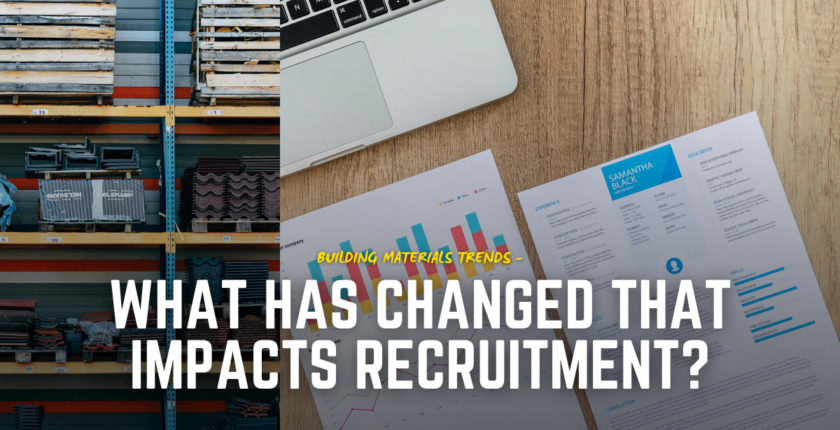Building Materials Trends – What has changed that impacts recruitment?
We are already over halfway through 2023! How did it go so fast?
2023 so far has been a challenging but successful year. In our previous blog about building product recruitment trends, our experts made some predictions of what they expect would change about recruiting in the industry.
In this blog, we will review the predicted trends and see how they’ve affected the industry. Then our experts look ahead to the rest of the year, to make predictions of what is going to change when hiring for your team.
Updates From Last Time
First, we’ll review our predictions from January 2023. Discussing if what our experts thought would come to pass has, or what has changed.
Here’s an update on what we predicted:
Update – Companies are going to streamline internally
In our previous blog, our experts suggested there’ll be an overall increase in redundancies. Whilst there have been a few redundancies, we’ve noticed them within larger businesses. Whereas within SMEs this seemed to be a rarity.
Our experts found that there have been two reasons why people have been streamlining:
Company Mergers
There is a number of buyouts that are currently underway- or are planned. For example, Stark has brought out both Jewsons and Gibbs and Dandy. This has resulted in a series of redundancies- and people looking for a new opportunity because of rebranding.
Over Populated Patches
Another reason is that some companies have recruited too many people for their teams. With some hiring 5-7 people covering 1 patch. This was due to Covid and how that changed the sector. However, they’ve realised that fewer people can do the job. So, with manufacturing and business costs rising as they are, companies are reducing headcount first to save money.
There may be more redundancies to come, but that’s due to the recession- but it’ll be nothing like the 2008 recession we saw.
Update – More candidates will be active on the market
Another prediction our experts made is that there’ll be more active candidates on the market.
The main reason for this is the increased amount of redundancies, which is leaving more people on the search. Salespeople are also under more pressure now, so are looking for a career move – see more about this in our latest prediction!
Although this does mean that you have more of a choice, the applicants may not be the best. So, your screening practices will have to be top-notch in order to select the right person for the business.
How will this impact you?
Having more candidates will give you more choices, but with that comes more work. With the increase in applicants, you will be screening more CVs, be in more interviews and be in more HR meetings- all of which takes time!
So, to use the time effectively, you’ll need to:
- Hone interviewing skills to a high level, so that you can make informed judgements.
- Have a process in place to go back to that person to ensure that the PR and Image is protected throughout.
Update – Fewer jobs on the market
The final recruitment prediction that our experts made was that there would be fewer jobs on the market.
Fortunately, we have found this hasn’t been as bad as it could have been.
There still was a slight drop, but it was only around 15-20%. This figure wasn’t anywhere near what we expected. In the early stages of the year (Q1) there were fewer positions available. However, Q2 saw this pick-up and in June there was a massive increase. So this is good news!
Although there is less of a choice in jobs for candidates, they still hold a lot of power. And our experts found that candidates will still turn down a job if it doesn’t meet their requirements.
How does this impact you?
In this market, if you find someone you really want you’ve got to do everything to win them over.
Keeping in touch, engaging and doing things in a timely manner is the best way you can do this.
Essentially, you’ll need to be proactive and alert. But you also need to deliver a recruitment service that will enhance your brand image – not impede it.
The main takeaway from this is that the job levels have not drastically reduced. Keeping the market competitive and thriving!
The trends for the rest of the year
Our experts have been busy, but they’ve made the time to make new predictions for the next part of the year. For the rest of the year, we expect to see some changes industrywide.
The overall predictions seem to be optimistic. But there seems to be a focus on preparation and getting ahead for the future. The rest of 2023 will be different to the first half, so stay tuned for the new trends.
An important detail to remember is that the trends will differ depending on the sector.
Trend 1 – Businesses will look for new opportunities to sell
The first trend that we predict to see for the few months is that businesses will look for new opportunities to sell.
There have been changes in the market within the first half of the year, that have forced businesses to search for new opportunities to sell. For example, organisations may need to look for more specifications or commercial sales.
If they can’t find these new opportunities, then businesses might need to reduce manufacturing capacity. You’d think that selling products would be the preferred option, as the process is simpler.
But a question you might ask is, how might the opportunities be found?
Trend 2 – Sales roles will change
Another trend that we believe we’ll see is the change in sales roles.
A lot of sales roles will move away from the account management style we’ve seen recently. Instead, they’ll be a shift towards to a more aggressive sales roles, where salespeople will be hunting for those opportunities. In a sense, you could say that it’s more your traditional sales role, where you’d find yourself picking up the phone a lot more.
But why?
Well, it’s our current climate and unfortunately there’s not a lot that can be done to change this. So it’s all about helping teams adapt to the new style of skills that are in demand!
But, something we are concerned about with this trend is that some employers could become less tolerant of underperformance. So, will be more harsh on salespeople. It’s understandable that you want teams to hit (or overachieve) targets. But, it’s important to consider is that it will take time for people to adapt.
Trend 3 – Getting ahead of the curve
The next few months will have a heavy focus on planning and preparing for 2024. As this is the only way companies can get ahead of the competition.
So far this year has been a bit flat, not terrible, but you could say it’s been okay. A positive we can take is that we are pretty much back to the pre-covid levels, which is nice to see. Especially with us not knowing how long it would take to recover!
Getting ahead of the curve will require businesses to adapt hiring strategies and we can see employers doing a couple of things:
- Start headhunting– rather than counting on candidates to come to them. As you’ll need to bring on the best of the best in order to stay ahead of the competition. Unfortunately, these people aren’t found on job boards!
- Looking to new sectors – Ultimately, you can learn a product or service. So businesses will need to start looking to the industries that cross over well to building materials. Then, work on transitioning them.
- Growing talent for the future– Ideally, companies should look to bring in fresh ideas and concepts – to help them innovate. With this, we expect that employers will start to look at apprentices and graduates. Although, apprenticeships can also be used to upskill your current team!
A little summary of the trends the building materials sector faces
2023 started off a little bit shakily but got better quarter by quarter. I think the rest of 2023 looks to be steadily going, with a focus on the future. Preparation will be key in these next few months for 2024.
Like the trends at the start of the year, it seems that there is links between the upcoming trends for the rest of 2023.
From the trends set at the beginning of 2023, it seems that we are expected to see the complete opposite in this half for you! To have the best 2024, it’s recommended to start planning now.
The experts behind these building materials recruitment trends
Natalie Chapman

Natalie Chapman is the division manager for our Building Materials Recruitment team. She has over 18 years experience of recruiting within the sector, so has seen everything from the recession to covid! She delivers a wealth of knowledge about recruitment and selection.
Adam Dolman

Adam Dolman, our director, has a background in recruiting in the building materials industry. Working in KBB industry and building materials sector. Not only does he bring insights from his nearly 10 years in the industry, Adam also brings new ideas that help you innovate recruitment practices.

